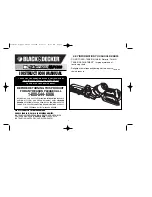
Helpline No 0844 801 8701 / IRE 189 094 6244
4
Safety regulations
Important. The following basic safety actions must be
taken when using electric tools in order to protect the
user from electric shocks and the risk of injury and
fire. Read and follow these instructions before using
the equipment.
1.
Keep your work area tidy
- Untidy work areas can result in accidents.
2.
Make allowance for ambient conditions
- Do not expose electric tools to rain. Never use
electric tools in damp or wet locations. Provide
good lighting. Do not use electric tools near
flammable liquids or gases.
3.
Guard against electric shock
- Avoid bodily contact with earthed parts (e.g.
pipes, radiators, cookers and refrigerators).
4.
Keep children away
- Do not allow other persons to touch the tool or
cable, keep them away from your work area.
5.
Keep your electric tools in a safe place.
-
Unused tools should be stored in a dry, locked
room out of children’s reach.
6.
Do not overload your tools
- Tools work better and safer when used within
their quoted capacity range.
7.
Use the right tool.
- Do not use tools or attachments too weak for
heavy duty work. Never use tools on jobs for
which they are not intended; for example, do not
use a hand-held circular saw to fell trees or lop off
branches.
8.
Wear suitable work clothes
- Do not wear loose clothing or jewelry. They can
be caught in moving parts. Rubber gloves and
nonskid footwear are recommended when working
outdoors. Wear protective hair covering to contain
long hair.
9.
Wear safety goggles.
- Use a dust mask when working on dusty jobs.
10.
Do not use the cable for purposes other than
that for which it is designed.
- Do not carry the tool by its cable and do not
use the cable to pull the plug out of the socket.
Protect the cable from heat, oil and sharp edges.
11.
Secure your workpiece
- Use clamps or a vise to hold the workpiece
securely. This is safer than using your hand and
also enables you to operate the machine with
both hands.
12.
Do not overstretch.
- Avoid abnormal working postures. Make sure
you stand squarely and keep your balance at all
times.
13.
Take care of your tools
- Keep your tools sharp and clean in order to
work well and safely. Follow the maintenance
regulations and the instructions for changing
tools. Check the power plug and cable on a
regular basis and have them replaced by an
authorized specialist if they are damaged. Check
the extension cable regularly and replace it if
damaged. Keep handles dry and free from oil and
grease.
14.
Pull the power plug
- When tools are not in use, before starting any
maintenance work or when changing attachments
such as saw blades, drill bits and all kinds of
mounted tools.
15.
Always remove keys and wrenches after use
- Before switching on, make sure that all keys
and wrenches have been removed from the
equipment.
16.
Avoid unintentional starting
- Never carry a tool with your finger on the switch
button while the tool is connected to the power
supply. Make sure that the switch is turned off
when connecting the tool to the power supply.
17.
Extension cables out of doors
- Use only authorized and accordingly labeled
extension cables out of doors.
18.
Be alert at all times
- Keep an eye on your work. Use common sense
when working. Never use the tool when you are
distracted.
19.
Check the equipment for damage
- Before using the tool each time, check the
safety devices or any slightly damaged parts to
ensure that they are in good working order. Check
that the moving parts are working correctly, that
they do not jam, and that no parts are damaged.
Make sure that all parts are fitted correctly to
ensure that the equipment remains safe to
use. Unless otherwise stated in the operating
instructions, damaged guards and parts have to
be repaired or replaced by a customer service
workshop. Damaged switches have to be replaced
by a customer service workshop. Never use tools
with a switch that cannot be turned on and off.
20.
Important.
- For your own safety you must only use the
accessories and additional units listed in the
operating instructions or recommended or
specified by the manufacturer. The use of
mounted tools or accessories other than those
recommended in the operating instructions or
catalog may place your personal safety at risk.
21.
Repairs may only be carried out by a qualified
electrician
- This electric tool complies with the pertinent
safety regulations. Repair work must only be







































